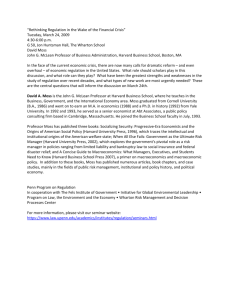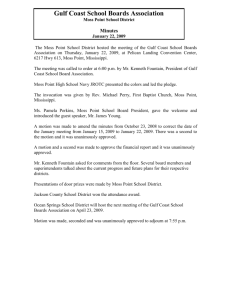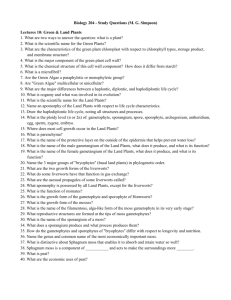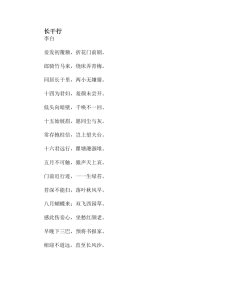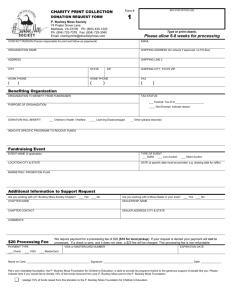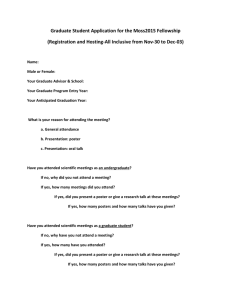Introduction to Government and Markets: Toward a New Theory of
advertisement
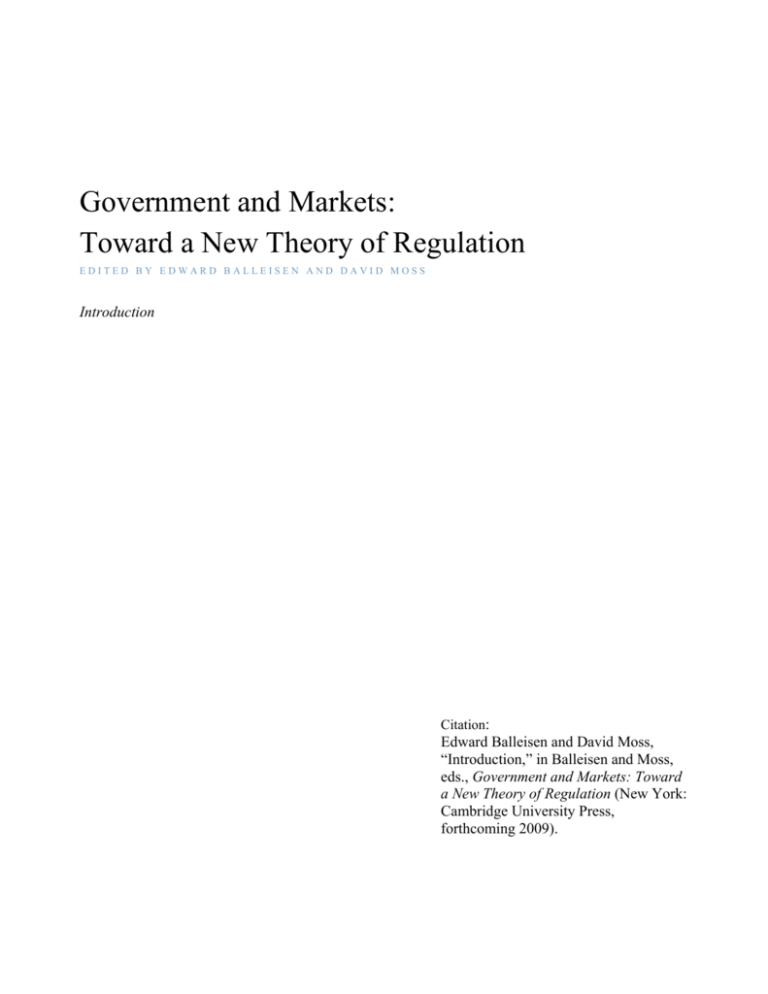
Government and Markets: Toward a New Theory of Regulation EDITED BY EDWARD BALLEISEN AND DAVID MOSS Introduction Citation: Edward Balleisen and David Moss, “Introduction,” in Balleisen and Moss, eds., Government and Markets: Toward a New Theory of Regulation (New York: Cambridge University Press, forthcoming 2009). Introduction EDWARD BALLEISEN ASSOCIATE PROFESSOR OF HISTORY, DUKE UNIVERSITY DAVID MOSS JOHN G. MCLEAN PROFESSOR OF BUSINESS ADMINISTRATION, HARVARD UNIVERSITY After more than a generation of deregulation and a presidential declaration that the “era of big government is over,” the political pendulum has apparently begun to swing back toward regulation. Calls for effective government action, long subdued, have grown louder and more numerous. The provocations are not hard to find: the financial crisis first and foremost, but also accounting scandals at some of the nation’s largest corporations (Enron, Worldcom, etc.); lead-tainted toys from China; E. coli outbreaks in the domestic food supply; collapsing levees and bridges; rising global temperatures and the threat of fundamental climate change. One might expect that American lawmakers, confronted by these many challenges, could turn to experts in the academy for guidance. Yet to a surprisingly large extent, the academic discussion has remained stuck in a deregulatory mindset, more focused on government failure than on the ingredients of government effectiveness or success. As a result, there is a real danger that the new round of regulation will be rooted not in new research and new thinking, but rather in old ideas that are conveniently dusted off and reused in the absence of anything better. This book represents an attempt by concerned academics to begin moving beyond old ideas about regulation – very old ones that informed earlier rounds of regulatory activity as well as more recent ones that drove a wave of deregulation beginning in the late 1970s. Now, with interest in regulation again on the rise, it is imperative that we not simply replay the past but move forward based on an improved understanding of the subject. New regulatory initiatives should be informed by past experience to be sure, but also by compelling critiques of the old approaches, as well as new insights about human behavior, regulatory capabilities, and societal needs. Such an ambition constitutes the essential motivation for this volume. Touchstones of the Prevailing View Within the social sciences – and particularly within economics, which as a discipline enjoys the greatest influence over public policy – thinking about regulation often starts with the notion of market failure. In an idealized economic market, individuals maximize the welfare of all simply by pursuing their own self-interest. Sometimes, however, in practice, the invisible hand of the market fails to optimize social welfare. The culprits, economists have taught us, are such things as public goods and externalities, which threaten to drive a wedge between individual and social welfare. Particularly in the 1950s and 1960s, and even into the 1970s, social scientists often regarded market failure as a sufficient justification for government intervention. Negative externalities such as industrial pollution, for example, had to be regulated or taxed. More generally, regulators were understood to be engaged in an ongoing search and destroy mission, with market failure as the target. Balleisen and Moss | Introduction 1 By the late 1970s, social scientists had begun paying more careful attention to the problem of government failure, showing increasing sensitivity to the possibility that even in the presence of market failure policymakers could potentially do more harm than good in their attempts to cure market ills. Policymakers, we learned, were always liable to be captured by special interest groups or otherwise diverted from serving the public interest as a result of weak incentives or ineffective monitoring. And even those policymakers with the best of intentions – and incentives – could fail as a result of inadequate information. So-called command-and-control regulation was seen as particularly vulnerable to information deficiencies since it was thought to run roughshod over the price mechanism, the pivotal purveyor of information in well functioning markets. Although market failure remained an important and much touted concept in the social sciences, government failure increasingly displaced market failure as a dominant subject of study. Article after article in the scholarly literature spotlighted government shortcomings and missteps and the scourge of unintended consequences. Indeed, as skepticism – even cynicism – began to displace optimism in academic thinking about government, pressure mounted in the policy arena for broadbased deregulation. Pushed forward by leading academics, from George Stigler to Alfred Kahn, the movement for deregulation reflected a profound shift in the nation’s intellectual climate, a shift which was first evident within the university itself. By the 1990s, the touchstones of the prevailing academic view of regulation, particularly in economics, thus included not only the old market failure framework but also a new economic theory of politics, rooted in rational-actor assumptions about individual decision making and interest group models of organized political activity. The term “regulation,” meanwhile, had become increasingly associated with words like “heavy handed” and “command and control,” a phrase which itself had taken on highly negative connotations, especially during the waning days of the Soviet Union and the collapse of communism. Toward a New View The goal here is not to try to demolish the existing intellectual foundation for academic thinking about regulation, but rather to try to strengthen it and add to it, fixing a few cracks and building from there. The essays that follow cut across the social sciences, reflecting the perspectives of economists and political scientists, legal scholars and sociologists, historians and professors of business administration. We have organized them under three broad headings: “Beyond Market Failure,” “Beyond the Economic Theory of Politics,” and “Beyond Command and Control.” Each section aims to enrich our understanding of regulation and to suggest promising directions for research, based in part on new lines of scholarship in related areas. Beyond Market Failure The concept of market failure, of course, like the possibility that regulatory policies might not achieve their intended goals, remains a powerful framework for thinking about regulation in many contexts, a point reinforced by Joseph Stiglitz’s essay. Stiglitz begins by identifying a series of contemporary market failures, but then moves on to highlight two additional rationales for regulation, market irrationality and distributive justice. Implicitly drawing on his extensive experience as a public official, he argues that vigorous regulatory governance – when well conceived and implemented – can effectively redress these shortcomings of the market. Like Stiglitz, the economist Michael Greenstone structures his analysis around the capacity of Balleisen and Moss | Introduction 2 government to respond effectively to market failure, in this case the Environmental Protection Agency’s Superfund Program, which seeks to clean up industrial sites contaminated by toxic waste. Greenstone reminds us that the success or failure of particular regulatory work remains an empirical question, insists that social scientists can do a much better job of marshalling an evidentiary basis for their assessments of regulatory outcomes, and encourages policy-makers to adopt an experimental mindset when framing regulatory interventions. For all the conceptual power of market failure, it has never served as the sole justification for regulatory action, even though much recent scholarship has tended to ignore alternative regulatory purposes. As the historian Mary Furner observes in her assessment of key intellectual developments within the American regulatory tradition, Americans have frequently conceived of regulatory policy not simply as a palliative for occasional market weaknesses, but rather as an integral part of a broader social system that encompasses economic institutions and relationships. The sociologist Neil Fligstein pursues a similar line of reasoning as he surveys the European creation of a far more vigorous competition policy since the 1957 Treaty of Rome. In European regulatory politics, moves toward opening up continental markets have worked precisely because European political leaders have carefully linked them to generous social welfare policies, thereby ensuring social legitimacy for the process of economic liberalization. The political scientist Daniel Carpenter explores yet another crucially important regulatory purpose – that of actually constituting market institutions in the first place. Using the case of post-World War II American pharmaceutical regulation as an evidentiary platform, Carpenter contends that effective regulation is often necessary to lay the groundwork for entire areas of exchange. Without regulatory policy that clearly articulates the rules of the economic game, Carpenter demonstrates, many economic sectors will lack sufficient confidence to drive investment and sustain high levels of consumption. Beyond the Economic Theory of Politics There can be no question that social scientists have made enormous progress applying economic assumptions and tools to the study of politics. The world looks very different once one views it through a prism of unwavering, rational calculation; and the academics who have adopted this prism have shown that political actors at all levels often aim to maximize their own self-interest, rather than the public interest, in their public decision-making. The contributions to the second section of the book all grapple with the still dominant presuppositions of rational/public choice, identifying a number of important conceptual and evidentiary limitations. The economist Donald Wittman shares many of the key theoretical assumptions of this approach to the study of politics and policy. But his essay maintains that many scholars have poorly applied neo-classical economic theory to politics, substantially understating the power of competition in political markets and, as a result, overstating the frequency with which concentrated interests frustrate the general welfare. In her wide-ranging review of the public choice literature, economist Jessica Leight offers a different critique of the dominant scholarly view of regulation, arguing that many of its leading advocates have overreached, in some cases pushing their conclusions well beyond available supporting evidence. Consistent with Leight’s critical assessment, David Moss and Mary Oey highlight three historical cases (passage of the Voting Rights Act, Medicare, and Superfund) in which the general interest actually trumped special interests. In each of these pivotal instances of American policy-making, Moss and Oey note, the power of the press to inform and Balleisen and Moss | Introduction 3 mobilize a broad electorate substantially blunted the capacity of special interests to dictate policy formulation. Drawing on social network theory, the legal scholar Yochai Benkler offers a fascinating but quite different perspective, suggesting that traditional economic assumptions – particularly those regarding self-interested rationality – need not be the starting point for all models of political decision making. Cooperative models of social and political behavior, Benkler argues, may prove just as powerful and also far more realistic (i.e., more consistent with evidence on human behavior) than the traditional models that privilege individualistic pursuit of narrowly defined economic gain. Benkler also shifts our attention to questions of institutional design, noting both how policymakers can seek to construct and nurture responsive regulatory mechanisms, and how they might avoid weakening socially useful cooperative ventures that have evolved in recent decades. Beyond Command and Control Moving from theory to practice, the essays that comprise the third and longest section of the book look beyond the standard caricature of regulation as heavy handed, command-and-control style intervention. Together, these papers highlight the remarkable diversity of regulatory tools available to public officials, while hinting at their comparative advantages and disadvantages as responses to particular kinds of regulatory challenges. The first four chapters – by the business scholar Mary O’Sullivan, the sociologist Monica Prasad, the legal scholar Elizabeth Warren, and the economist Barry Eichengreen – examine the viability of some well-worn regulatory tools against the backdrop of especially important public policy challenges. O’Sullivan explores the complex task of reworking the regulation of corporate governance, raising searching questions about the utility of shareholder value as a sufficient lodestar for policy-making in this area. Prasad turns our attention to tax-based regulation, a mechanism that governments have long used to constrain disfavored economic activities, and considers its logic, promise, and limits, particularly in the context of pressing environmental challenges. Warren investigates the continuing potential relevance of standard administrative approaches to regulatory rule-making and oversight, asking whether the Consumer Product Safety Commission – a traditional regulatory agency of sorts, but with a relatively light touch – should serve as a model for a new commission to regulate retail-level financial services, including both consumer and mortgage lending. Eichengreen identifies several causes of the mortgage debt crisis that began to roil financial markets in the late summer of 2007, and then makes a case for tightened regulation of American banks, which he sees as continuing to serve as linchpins of the new, globalized financial system. The final set of essays critique the common impulse to draw excessively stark distinctions between public and private regulatory governance. Drawing on an increasingly rich literature within political science, sociology, and law, the historian Edward Balleisen explores a wide range of rule-making and oversight mechanisms that depend on non-state actors, often from within the business community itself. Generally portrayed as the polar opposite of traditional command and control, these strategies of private regulatory governance can prove to be more powerful and effective than its many critics presume. But Balleisen stresses that such outcomes depend heavily on a framework of “co-regulation,” in which meaningful government monitoring and a credible threat of government regulation stand behind private regulatory efforts. Similarly focused on quasi-private regulation, the legal historian Tony Freyer identifies legal action as a potent regulatory tool, particularly in the area of anti-trust and tort. As federal anti-trust suits became less frequent and as enforcement of many Balleisen and Moss | Introduction 4 health and safety regulations weakened during the age of deregulation, he shows that private antitrust and tort actions quickly filled the void. While Freyer’s article suggests that widely shared popular support for regulatory action abhors a vacuum, the essay by the political scientist Marc Eisner probes the complicated implications of deregulation as a regulatory strategy. Focusing on the dismantling of many federal regulatory controls in transportation and energy during the 1970s and 1980s, Eisner illustrates how government rule-making has continued to powerfully shape these supposedly now unregulated sectors of the economy. A New Agenda for Research The essays presented here, then, offer several compelling directions for rethinking overarching approaches to regulatory policy in the United States, alongside numerous concrete suggestions for legislative and administrative policy-makers. Initially written for a February, 2008, conference on the past, present, and future of the American regulatory state, the volume’s contributions also point toward an interdisciplinary research agenda for a new generation of scholarship about regulatory strategies and institutions. The authors by no means agree with each other on every issue about regulatory policy or the best way to conceptualize and study it. Nonetheless, their work collectively suggests the following elements of an emerging new perspective on regulation: a) Vibrant capitalism is dependent upon, and even constituted by, sensible regulation. There is no “market” without regulation that defines property rights, sets standards for business practices, and creates widespread confidence in the fairness of the economic “rules of the game.” To imagine the world in terms of pre-existing “markets” and intrusive “government” is to conjure up an unhelpful fiction. b) The still prevailing academic analysis of regulation, rooted in public choice and the economic theory of politics, has some key weaknesses. In particular: *The public officials charged with making and enforcing regulatory law are not always driven predominantly by a savvy pursuit of self-interest, narrowly defined. Legislators and regulators also seek to protect/enhance their reputations. They at least sometimes focus on what they perceive to be the broader “common good.” And their perceptions of that “public interest” are significantly influenced by prevailing “narrative frames” about the appropriate purposes of government. *Voters are not always “rationally ignorant” about regulatory issues. Social and political movements can raise public awareness. Voters also do not universally cast their ballots with regard to their self-interest, narrowly conceived. Like policy-makers, they also have a deeper sense of the broader common good, shaped not only by their own experience but also by popular ideas about the legitimate roles of government. *Economic actors – managers, consumers, workers, investors, lenders, insurers, etc. – do not always behave as strictly rational calculators of interest, whether their aims involve narrow self-interest or the broader public good, and whether they possess solid information about economic conditions or face circumstances of uncertainty. Sometimes they act according to the wisdom (or madness) of crowds, and sometimes their choices are powerfully shaped by Balleisen and Moss | Introduction 5 subtle contextual circumstances that may be beyond their control or even beyond their awareness. *For many individuals, the pull of social cooperation frequently outweighs selfish impulses. For such cooperatively-inclined people, efforts by policy-makers to create monetary incentives can backfire, diminishing intrinsic motivations. c) Achieving greater allocative or productive efficiency is not the only legitimate goal for regulatory initiatives. Concern for distributional outcomes and for the health of democratic political institutions must also have a place in shaping regulatory policy. d) The institutional matrix of regulation rarely involves only “government regulators” and “regulated businesses.” Instead, a broad array of third parties, including commercial counter-parties, industry associations, non-governmental organizations, quasi-public institutions of self-regulation, and even the press, play important roles in the regulatory process, with regard to both standard-setting and enforcement. e) Regulatory policy-makers need to appreciate the vast array of regulatory tools available to them. These tools range from taxation, to enforcement of civil liability for tort, to mandates for information disclosure, to the prohibition of particular goods or services, to the detailed rule-making and inspection regimes characteristic of “command-and-control,” to the delegation of regulatory oversight to self-regulatory bodies. In most regulatory contexts, the key issue is how to select the optimal mix of such tools. Each of these propositions, of course, leaves crucial questions unanswered, especially from the vantage point of a policy-maker struggling to respond to some regulatory dilemma. What circumstances facilitate concern for the public good, rather than the impulse to seize bureaucratic turf or feather one’s nest? In which contexts do economic actors predictably act irrationally, or prefer social cooperation to self-regarding strategies? How does one sensibly balance regulatory purposes against one another? In what situations do particular regulatory strategies tend to work well or poorly? The essays that follow only begin to answer these questions, while identifying other useful points of departure for additional inquiry. This reality explains the book’s subtitle. We see the volume as pointing the way toward a new conceptual framework for regulatory policy. Our hope is that social scientists interested in regulation will pursue the trails – the agenda – laid out in the pages ahead. In a brief conclusion, we flesh out the shape of that agenda, drawing on both the essays themselves and the conference discussions that they prompted, which focused on identifying the most important research questions that social scientists should be pursuing about the regulatory role of the state. Balleisen and Moss | Introduction 6


